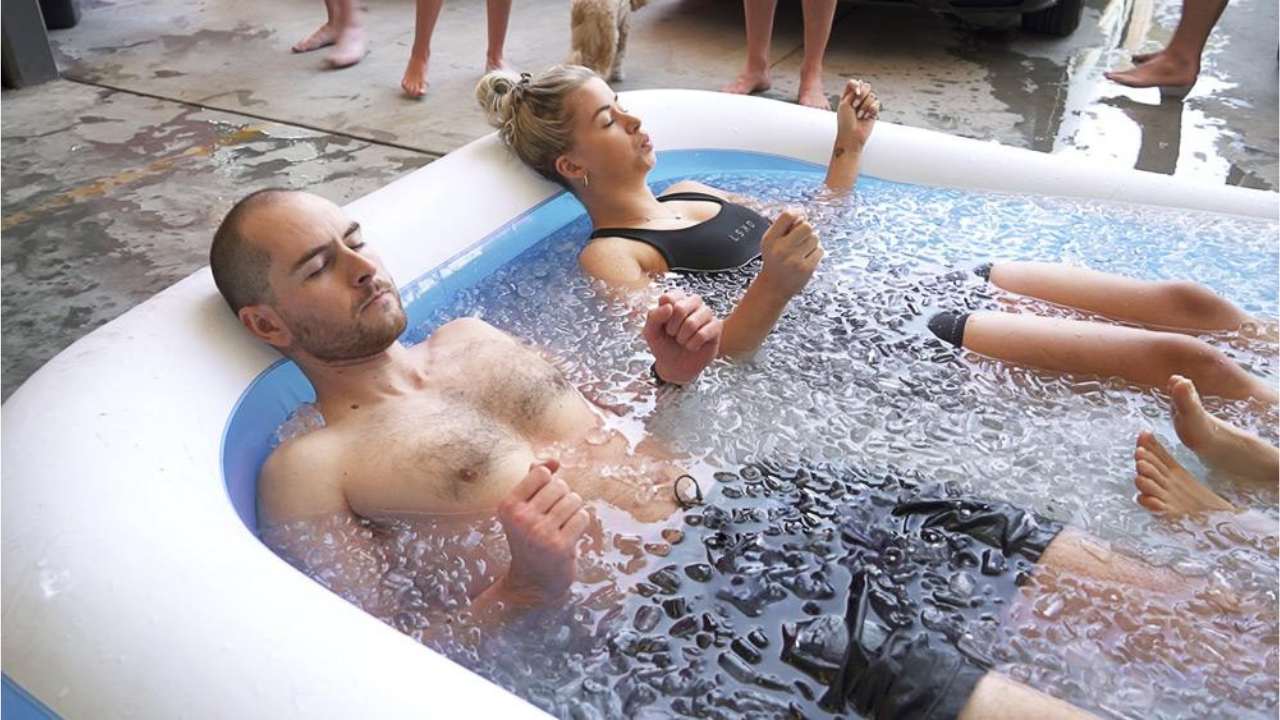Are Ice Baths Good For You? The Benefits Revealed!
Taking an ice bath regularly has many potential benefits, including improved circulation, decreased inflammation and improved immunity.

Ice baths, also known as cold-water immersion therapy, are widely known among athletes and fitness enthusiasts.
However, some people are skeptical about the supposed benefits of this extreme therapy in ice cold water.
Are ice baths really good for you or just a trend? In this article, we will explore the health benefits of taking ice baths and share some tips to maximize their positive effects.
Health Benefits of Taking Ice Baths:
Numerous studies have demonstrated that cold-water therapy can bring many health benefits to both your body and your mind.
One of the most noteworthy benefits is its ability to reduce inflammation, which is a root cause of many chronic diseases. Ice baths can also help alleviate sore muscles, relieve pain, and reduce swelling.
Additionally, after a workout, an ice bath can help lower your core body temperature and prevent overheating due to the cold exposure.
If you want to know what to set the temperature to, check out our article on how cold and ice bath should be!

Cold Therapy And The Cardiovascular System
Athletes often experience improved cardiovascular functioning due to CWI (Cold Water Immersion) treatments, from increased blood flow to lower blood pressure.
To comprehend the power of this cryotherapy and its relation with heart rate, let's first explore how the cardiovascular system responds to it.
Effects On Circulation and Blood Pressure
By modulating processes such as vasoconstriction and vasodilation, immersing oneself in freezing cold water can cause the blood vessels constrict.
When they dilate and contract, it can lead to enhanced pliability of these pathways.
This helps with increased circulation throughout the body.
The frequent opening and closing of the blood vessels throughout the body contributes to a significant increase in overall health, particularly by helping regulate healthy blood pressure.
When your circulatory system is more agile and responsive, it can better adjust accordingly for optimal functioning.
What Mental Toughness Can You Build From Regular Ice Baths?
Apart from the physical benefits, ice baths can also help build mental toughness.
After all, if you can withstand the shock of plunging yourself into nearly-freezing water, you can probably handle any obstacle that life throws your way.
Regular exposure to extreme cold can help you develop resilience, self-discipline, and focus.
Moreover, cold therapy has been shown to boost cognitive function, which translates into better decision-making, faster reaction times, and improved creativity.

Physiological Changes After an Ice Bath:
When you take an ice bath, your body undergoes profound physiological changes.
Your blood vessels constrict, which decreases blood flow to the surface of the skin and the extremities.
Your heart rate slows down, and your breathing becomes shallow. The sudden drop in temperature triggers a release of endorphins, which are natural painkillers produced by the brain.
Additionally, cold therapy activates the parasympathetic nervous system, which helps promote relaxation and reduce tension.
How an Ice Bath Can Boost Your Immunity and Help With Muscle Recovery:
Another fantastic benefit of ice baths is that they can improve your immune system functioning, making you less susceptible to colds, infections, and other illnesses.
Cold-water immersion increases your white blood cell count, which are responsible for fighting disease and illness.
Moreover, taking an ice bath after a workout or an intense physical activity can help speed up muscle recovery and reduce muscle damage.
This is because the cold water helps flush out lactic acid and other waste products that build up in the muscles during exercise.
Benefits of Cold Immersion Therapy
Some ice bath benefits whether you are taking a cold bath or cold showers include:
- Reduces inflammation - The application of cold temperate can help reduce inflammation caused by injury or illness by constricting blood vessels and decreasing metabolic rate. This can result in reduced swelling and joint pain.
- Treats chronic pain - Applying ice-cold temperatures to the affected area is believed to change how signals are transmitted from sensory neurons, reducing sensitivity and therefore easing discomfort caused by conditions like arthritis and fibromyalgia.
- Improves athletic performance - One study shows that cold water baths reduce muscle soreness after a hard workout, promoting better recovery times so you can perform at your best more regularly.
- Enhances immunity - Studies suggest that regular exposure to cold temperatures increases white blood cell count as well as production of anti-inflammatory cytokines which are necessary for a healthy immune system response.
- Increases alertness - Exposure to icy-cold temperatures has been linked with increased mental alertness due to heightened brain activity after the stimulation from the shock of colder temperatures.
- Promotes weight loss - In addition to enhancing metabolism directly through its impact on the central nervous system (CNS), researchers have theorized that other factors like increased endorphin levels might contribute towards fat burning capabilities when using cold water immersion therapy on a regular basis.
- Releases stress & tension – Taking an occasional cold shower has been shown to relieve stress and tension due to its deep relaxation effect on both mind & body while simultaneously calming down overactive nerves & muscles which helps combat fatigue & depression symptoms naturally without any negative repercussions unlike conventional drug treatments prescribed for similar ailments

Potential Risks of Regularly Taking Ice Baths:
While ice baths have numerous benefits, there are some potential risks involved. The most common side effect of cold therapy is hypothermia, which occurs when your body temperature drops too low.
Hypothermia can lead to shivering, confusion, dizziness, and even death in extreme cases.
Additionally, taking an ice bath too often can interfere with your body's ability to adapt to changes in temperature. In rare cases, cold water immersion can trigger heart arrhythmias or spasms in people with heart problems.
- High blood pressure – Long term exposure or extreme cases of temperature less than 4°C may cause spikes in blood pressure levels due high sympathetic nervous system stimulation caused by shock like reactions within our bodies resulting in hypertension related problems if caution isn’t taken while undergoing this form of medicinal treatment
- Chills – Prolonged freezing conditions may cause shivering which is associated with chills mainly caused by our bodies instinctive defense mechanisms kicking into gear when trying too shield us from hypothermic states due too exposure lasting more than few minutes
- Hypothermia – Accidental or deliberate exposure for periods longer than 15 min could lead too low body core temperature levels leading on too dangerous medical condition known as hypothermia unless prompt medical attention is sought immediately upon experiencing any kind off systemic changes post submerging ourselves under such extreme environmental conditions. Hypothermia is the leading cause that makes an ice baths dangerous.
Strategies to Maximize the Benefits of Taking an Ice Bath:
If you decide to try ice baths, there are a few things you can do to maximize their positive effects.
First of all, start with shorter exposure times, gradually increasing the duration as your body becomes more acclimated. Always monitor your body temperature and avoid going too low.
After getting out of the ice bath, take a warm shower hop in a sauna or wrap yourself in a blanket to raise your body temperature.
Finally, try to take ice baths after your workouts, when your muscles are already warm and relaxed.

Most Commonly Asked Questions
With so many potential benefits, it's no wonder that people are interested in taking ice baths. But with the potential risks involved, it can be hard to know if they're safe and how best to maximize their effects.
You don't want to take unnecessary risks when trying something new, especially when it comes to your health. So you need answers about the safety of ice baths and strategies for getting the most out of them without putting yourself at risk.
We've got you covered! We have answered all of your questions around ice baths so that you can feel confident about giving them a try safely and effectively. From understanding hypothermia risk factors to learning how long is too long for an exposure time - we have everything you need to make sure that your cold therapy experience is both beneficial and enjoyable!
How long should you ice bath for?
Ice baths are an increasingly popular way of aiding recovery from strenuous exercise. The practice consists of sitting in a tub filled with cold (50-60 degrees Fahrenheit) water and ice for a set amount of time, usually between 5-10 minutes.
The primary benefit associated with an ice bath is the reduction in inflammation, which helps athletes recover quicker after intense workouts. Additionally, studies have shown that regular use of ice baths can lower overall body temperature, which can help reduce soreness levels and improve the effectiveness future workouts.
So when taking an ice bath always make sure you follow the correct protocol: Use cold water only (50-60F), limit your time spent bathing between 5-10 mins maximum and ensure all moisture is wiped off once you’re done before wrapping yourself up in warm clothing shortly afterwards!
What are the negatives of ice baths?
Ice baths, also known as cold water immersion (CWI), have become popular for treating acute and overuse injuries. While there is evidence that suggests ice baths may have beneficial effects, it's important to be aware of the potential risks before jumping in.
The most commonly reported negative side effects of CWI are tissue damage due to prolonged exposure to cold temperatures, tightness in muscles which can create an imbalance leading to faulty movement patterns and further injury, decreased heart rate variation which reduces our body's ability to adaptively respond during exercise or physical activity, an increased risk of hypothermia and frostbite if the bath is too cold or you remain in the bath too long.
There is also an increased risk of dehydration when combined with other activities such as sauna use or exercise where sweat loss can be significant. Additionally CWI may contribute to a decrease in performance for higher intensity workouts because oxygen delivery and muscle temperature regulation is reduced when compared with other methods like active recovery modalities like gentle jogging or cycling at low intensities.
Is it good to have a ice bath Everyday?
No, it is not recommended to take an ice bath every day. Cold immersion therapy can be beneficial for recovery from exercise and reducing inflammation, but doing it too often can actually lead to difficulty recovering after strenuous physical activity, as well as lower your tolerance to cold.
It's best to consult a doctor or specialist if you are considering making cold immersion therapy part of your regular routine.
How often should I ice bath?
Generally speaking, it is recommended that you take an ice bath two to three times per week for 5 minutes per session. Additionally, it is important to start slowly and gradually increase the duration and frequency, as going too intensely can be detrimental to your health.
Are ice baths good for you?
Ice baths can be beneficial for certain individuals, as cold immersion therapy has been shown to promote numerous health benefits such as increased energy, improved circulation and reduced inflammation.
However, the frequency and duration of ice baths should be carefully monitored to ensure it is done properly, and it is recommended to consult a doctor or specialist before starting a regular ice bath routine.
Final Thoughts on Are Ice Baths Good For You?
In conclusion, taking ice baths can be incredibly beneficial for both your physical and mental health.
This powerful therapy can help reduce inflammation, alleviate pain and soreness, build mental toughness, boost your immunity, and speed up muscle recovery.
However, it's essential to take precautions to avoid potential risks such as hypothermia.
By starting with shorter exposure times, monitoring your body temperature, and gradually increasing the duration, you can safely reap the benefits of ice baths. So, are ice baths good for you? The answer is a resounding YES!

